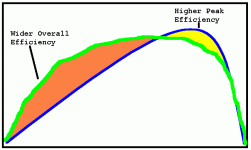Hi experts, after studying lots of posts here i am a little confused und hope to get some enlightening help from you :
my equipment :
5303 with 40A controller
408 with 20A controller
GL-1 with "comfort" controller from a German supplier
Since i have two trikes i had the chance to test all motors in direct comparison in terms of torque, accelleration, efficiency , range etc.
( i must add that my main objective was to operate the drives in the speed and current range giving highest possible efiiciency and lowest possible noise by using my 14 gear hub).
My findings are somehow surprising :
the GL-1 is by far the most efficient drive, but terribly noisy (it it somehow a sharp ringing noise) operated at 9 Amps full throttle constantly on a 3% inclination test distance my CA shows 1.8 Ah drawn from battery (Li 40V).
next is the 408 motor
it is the quitest motor and is performing the test distance consuming 2.3 Ah (same torque, same speed)
from the spec sheets provided at Crystalyte i expected from the 5303 an even higher efficiency, but the 5303 is slightly more noisy and draws 2.9 Ah from the battery.
I tried to operate the 5303 at 15A and 20A expecting some better efficiency, but it got worse to 3.2 Ah at 260 rpm of the motor and 3.6 Ah (double the consumption of the GL-1) at 340 rpm of the motor.
I have read :
Lowell : My X503 is much louder than the X5304, which is to say the X5304 is virtually silent, whereas the X503 is audible at certain speeds.
The7 : Motors of case 2 (GL2, BMC/Puma) usually have smooth drag and their back emf are (nearly) sinusoidal. In general they have a less average drag and a bit quietr in running.
I have ordered a Brushless controller evaluation kit from ST- and want to test the different motors with sinusoidal feed. http://www.st.com/stonline/products/literature/an/12375.pdf
Question is :
Is highest efficiency really linked to increased noise?
How is the 408 / 5303 are performing beeing fed with sinusoidal PWM?
What are your experiences
my equipment :
5303 with 40A controller
408 with 20A controller
GL-1 with "comfort" controller from a German supplier
Since i have two trikes i had the chance to test all motors in direct comparison in terms of torque, accelleration, efficiency , range etc.
( i must add that my main objective was to operate the drives in the speed and current range giving highest possible efiiciency and lowest possible noise by using my 14 gear hub).
My findings are somehow surprising :
the GL-1 is by far the most efficient drive, but terribly noisy (it it somehow a sharp ringing noise) operated at 9 Amps full throttle constantly on a 3% inclination test distance my CA shows 1.8 Ah drawn from battery (Li 40V).
next is the 408 motor
it is the quitest motor and is performing the test distance consuming 2.3 Ah (same torque, same speed)
from the spec sheets provided at Crystalyte i expected from the 5303 an even higher efficiency, but the 5303 is slightly more noisy and draws 2.9 Ah from the battery.
I tried to operate the 5303 at 15A and 20A expecting some better efficiency, but it got worse to 3.2 Ah at 260 rpm of the motor and 3.6 Ah (double the consumption of the GL-1) at 340 rpm of the motor.
I have read :
Lowell : My X503 is much louder than the X5304, which is to say the X5304 is virtually silent, whereas the X503 is audible at certain speeds.
The7 : Motors of case 2 (GL2, BMC/Puma) usually have smooth drag and their back emf are (nearly) sinusoidal. In general they have a less average drag and a bit quietr in running.
I have ordered a Brushless controller evaluation kit from ST- and want to test the different motors with sinusoidal feed. http://www.st.com/stonline/products/literature/an/12375.pdf
Question is :
Is highest efficiency really linked to increased noise?
How is the 408 / 5303 are performing beeing fed with sinusoidal PWM?
What are your experiences



